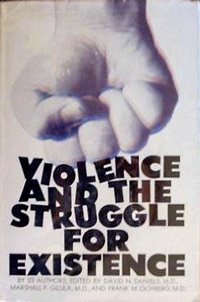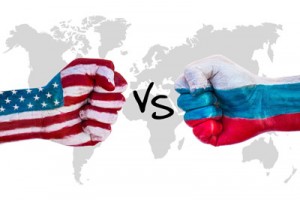Understanding Anger and Rage, the Socially Unacceptable Emotion
SYNOPSIS of the BLOG ARTICLE: Understanding the emotion “anger” and learning how to work “with it” gets us closer to ending unnecessary violence. Anger, in particular, is one of emotional alarm systems system that tells us about personal violation and its potential threat to our survival. It alerts us when our sense of inherent worth comes under attack; when getting what we want, need and/or value gets threatened; and when we can’t process feelings of shame, hurt, or fear.
 I began my study of violence in 1968 with other junior colleagues in the Department of Psychiatry at Stanford University after the assassinations of Martin Luther King and Robert F. Kennedy. Our work culminated in 1970 with the publication of a book called Violence and the Struggle for Existence.
I began my study of violence in 1968 with other junior colleagues in the Department of Psychiatry at Stanford University after the assassinations of Martin Luther King and Robert F. Kennedy. Our work culminated in 1970 with the publication of a book called Violence and the Struggle for Existence.
My interest in working with anger and violence continues into the present as a result of my association with the Enneagram Prison Project (EPP), working closely with colleagues Susan Olesek and Suzanne Dion, leaders of the project and the EPP’s core instructors, both teaching weekly in California jails and prisons. Together, we bring a great knowledge of the Enneagram and possess a deep understanding of the mammalian emotional alarm systems, including that of anger, to the EPP’s curriculum. This past month, Suzanne and I have put this paper together.
Acceptable Emotion: Can Understanding Lead to Less Violence?
by David Daniels, M.D.
with Suzanne Dion, one of the founding board members of the Enneagram Prison Project (EPP)
Anger is a vital, vital energy source. It’s one of the three fundamental, aversive emotions shared by all mammals. These aversive emotions are key to the survival systems found in human beings and mammals alike. They are designed to protect us, warn us, and keep us alive.
How the Anger System Works
 Anger, moreover referred to as rage, is part of the survival system that tells us about violation. It gets triggered when our sense of personal worth comes under attack, when getting what we want or desire is delayed or taken away, when something we care about gets threatened. It manifests when someone is about to take away our food, get in the way of our accomplishing something, or when someone tries to force us to do something against our will.
Anger, moreover referred to as rage, is part of the survival system that tells us about violation. It gets triggered when our sense of personal worth comes under attack, when getting what we want or desire is delayed or taken away, when something we care about gets threatened. It manifests when someone is about to take away our food, get in the way of our accomplishing something, or when someone tries to force us to do something against our will.
Anger/Rage is the emotion that comes online when issues of power or control come into question. Additionally, circumstances or people that stir feelings of powerlessness or that indicate that we’ve lost control of our autonomy trigger the anger/rage system. Anger is manifested physiologically, and very rapidly, and before cognition takes place. It occurs when we are wrestling with the subjective experience of personal violation, including threats to our identity, well-being, or core values.
The Ways We Use Anger
 Additionally, anger/rage is often ignited to defend an internal response to being hurt, humiliated, degraded, or shamed. Each of these unwanted internal feelings are particularly hard for us to process. It requires a great deal of presence to acknowledge these very delicate reactions, let alone hold ourselves compassionately through them and stay receptive. Therefore, in place of dealing directly with these unwanted feelings, anger/rage is often the emotion that’s deployed that gets us through the unwanted situation and unwanted feelings. Anger/Rage attempts to quickly resolve what is so profoundly difficult for us to deal with — those self-effacing, hurtful feelings that are in the end, associated with the threat of a life-threatening separation, the loss of connection to others and, ultimately, to our tribe.
Additionally, anger/rage is often ignited to defend an internal response to being hurt, humiliated, degraded, or shamed. Each of these unwanted internal feelings are particularly hard for us to process. It requires a great deal of presence to acknowledge these very delicate reactions, let alone hold ourselves compassionately through them and stay receptive. Therefore, in place of dealing directly with these unwanted feelings, anger/rage is often the emotion that’s deployed that gets us through the unwanted situation and unwanted feelings. Anger/Rage attempts to quickly resolve what is so profoundly difficult for us to deal with — those self-effacing, hurtful feelings that are in the end, associated with the threat of a life-threatening separation, the loss of connection to others and, ultimately, to our tribe.
While anger/rage is an aversive, “highly disturbing” emotion, it is readily available, action-oriented, and more tolerable to experience than the onslaught of feelings like self-hate, humiliation, unwanted-ness, distress, and shame. As we become angry, our body’s muscles tense up. Inside our brain, neurotransmitter chemicals known as catecholamines are released, causing us to experience a burst of energy that can last for many minutes. This burst provides us with ample fuel to take immediate protective, directed, and assertive action. At the same time, our heart rate accelerates, our blood pressure rises, and our breathing rate increases. Our faces may flush as increased blood flow floods our extremities in preparation for physical action. Our amygdala, deep in the brain’s limbic system, is so efficient at warning us about violation that it gets us immediately charged up and reactive. Our attention narrows and becomes locked onto the target, the “cause,” of our upset.
We then justify our anger by focusing it out on others and/or the environment, either of which becomes the “perpetrator.” We become ready to fight or flee. In the moment that anger/rage arises, what’s interesting to become a witness to is whether the anger we’re running is responding directly to perceived violations or is covering the distress felt from painful feelings like shame, humiliation, or unwanted-ness?
What’s Shame Got to Do With It?
 Let’s talk about shame for a moment. Shame is so powerful. It’s a long-known fact that you can pretty easily control others by shaming them. It’s one of the most common ways parents and teachers, who don’t know any better, gain control over their kids or manage their classrooms. Shaming the behaviors you don’t want is a tried-and-true method of over-powering someone psychologically. Both children and adults attempt to cover feeling “shamed” in many ways, because shame is one of the nastier feeling states. It differs from the three primary aversive emotions – anger/rage, fear/terror, and distress/hysteria. Shame attacks the self-esteem, it violates how loveable or unlovable we perceive we are, and how worthy we feel we are or are not, in our relationships.
Let’s talk about shame for a moment. Shame is so powerful. It’s a long-known fact that you can pretty easily control others by shaming them. It’s one of the most common ways parents and teachers, who don’t know any better, gain control over their kids or manage their classrooms. Shaming the behaviors you don’t want is a tried-and-true method of over-powering someone psychologically. Both children and adults attempt to cover feeling “shamed” in many ways, because shame is one of the nastier feeling states. It differs from the three primary aversive emotions – anger/rage, fear/terror, and distress/hysteria. Shame attacks the self-esteem, it violates how loveable or unlovable we perceive we are, and how worthy we feel we are or are not, in our relationships.
Shame triggers the impulse to hide oneself from exposure, to cover some part of self that would result in banishment and exile. Shutting down and withdrawing when shamed is common. Withdrawal causes us to cast our eyes downward, lower our head, and blush or retract. It’s the utter experience of “being unacceptable,” leading us to be excluded from the group, the family, the tribe — exclusion that would render us unable to survive. Covering shame happens by using anger and aggression, as well as something called “counter-shame.” It’s quite protective if you think about it. These mechanisms attempt to keep us from feeling something so horrible and unbearable within.
By running anger instead of nose-diving into shame, we can deflect feelings we cannot process, feelings that overload the system. Anger can successfully help us to avoid our shame as well as other painful emotional states.
And Then, There’s Counter-Shame
Counter-shame which, like anger, covers shame by focusing attention outward. But counter-shame has a twist. It’s a mechanism built on a constructed denial. There’s a “look at me, I’m so fine” stance. Counter-shame sets out to display an un-shamed self and instead deflects shame by showing off, entitlement, acting audaciously, omnipotent and invulnerable, pretending and denying, even becoming obnoxious, reckless or apathetic to the self or others all to portray the exact opposite of the shame feared.
Anger is, in many ways, simpler to deal with than counter-shame, as anger’s a straight line to the issue at hand or the incident. While it’s not pleasant, it’s direct. Counter-shame is an attempt to feel good and look good when one feels really bad. Counter-shame leads us far from the truth of ourselves and of others. Counter-shame can create a lot of indirect, unresolved conflict, harming relationships in the long run as what’s being acted out gets farther and farther from our authentic experience. The shame gets buried deep within and is never processed. It is best to confront counter-shame for what it is, so we can work with the shame itself, rather than hiding under counter-shame strategies. As difficult as it is, allowing shame to be felt/experienced allows it to be owned and processed, and readily dissipated, rather than acted out, covered up, and left to erode our sense of self.
The Social Acceptability of Anger/Rage
 Of the three aversive emotional systems – anger/rage, fear/terror, distress/hysteria – anger is the easiest to experience and is in fact the more socially acceptable emotion of the three. It’s got power in it. It’s got action in it. It’s the one we can tolerate more readily as compared to fear/terror or distress/hysteria. Take a look at anger/rage in today’s society. It’s so commonly depicted as abject violence, escalating without hesitation across various forms of modern-day entertainment as “the exciting” way to solve problems or conflicts. Even in this day-and-age when collective violence could destroy the planet, it’s still promoted as act of strength and machismo, featured across big-budget films and everyday television programming.
Of the three aversive emotional systems – anger/rage, fear/terror, distress/hysteria – anger is the easiest to experience and is in fact the more socially acceptable emotion of the three. It’s got power in it. It’s got action in it. It’s the one we can tolerate more readily as compared to fear/terror or distress/hysteria. Take a look at anger/rage in today’s society. It’s so commonly depicted as abject violence, escalating without hesitation across various forms of modern-day entertainment as “the exciting” way to solve problems or conflicts. Even in this day-and-age when collective violence could destroy the planet, it’s still promoted as act of strength and machismo, featured across big-budget films and everyday television programming.
 We have many rationales for having made rage and violence socially acceptable, e.g., anger/rage is directed readily toward an enemy group or nation, anger/rage is used in the name of defending against perceived threats, anger/rage is the precursor for the death penalty, and anger/rage is used daily as a form of intimidation, unrelenting leadership, and power. Because of its social acceptance, because of its visibility and promotion to developing children of all ages, it is fast becoming the most difficult behavioral response system to manage let alone talk people out of.
We have many rationales for having made rage and violence socially acceptable, e.g., anger/rage is directed readily toward an enemy group or nation, anger/rage is used in the name of defending against perceived threats, anger/rage is the precursor for the death penalty, and anger/rage is used daily as a form of intimidation, unrelenting leadership, and power. Because of its social acceptance, because of its visibility and promotion to developing children of all ages, it is fast becoming the most difficult behavioral response system to manage let alone talk people out of.
Anger’s destructive aspects – wounding and dominating another, inflicting pain, destroying what we hoped would change all the way to committing horrific acts of violence – hurts us, ALL OF US, and sadly, oftentimes actually diminishes our ability to get what we and others really wanted and valued in the first place. Moreover, as Will and Ariel Durant said in their book, In The Lessons of History, “…everything that has been accomplished through violent action has also been accomplished through non-violent action.”
It is in this profound understanding that we can learn to use the anger/rage system in more thoughtful, strategic, and kind ways. This is where constructive action resides, and where peace within ourselves as well as in the world, can be fostered.
Useful Steps When Working with Anger/Rage:
-
- Remember, anger/rage occurs rapidly and wants us to take immediate action. It’s so important that we notice our first reactions, as they take hold in our body the burst of energy, the tensing of our muscles, the increased heart rate and increased blood flow, all of which are associated with the sympathetic nervous system and its response to the alarm system of anger/rage.
-
- Once we’re self-witnessing, pause. Breathe in with full breathes, which helps relax the sympathetic nervous system’s responses. This also turns on the parasympathetic nervous system, which automatically regulates and stabilizes the hyped-up involuntary systems like our heart rate, glandular and intestinal activities.
-
- Allow ourselves to become centered and grounded in what’s called “receptive presence.” Often, just recalling a time when we were really “here,” grounded in ourselves, and feeling loved allows us to be receptive in the “now” moment. Practicing this is key and can make a great difference. Those with difficulty becoming openhearted can simply go to a time of kindness or love or peace in their lives. Just recalling that experience can change our actual cognitive-emotional state in the present moment.
-
- Using genuine curiosity, inquire. What is the anger alerting us to? Is it about not getting what we want? Is it about repressing hurt or shame? Or, is something that we value being violated or taken from us? Next, look around us. Can we take into consideration the impact our anger/rage may be having on others? What does it look like? Is our anger effective in the moment or is it not leading to a constructive outcome?
-
- Lastly, explore positive alternatives to simply acting out the anger, alternatives that respect both self and others. Anger is great for taking immediate action, it is a great vital source of energy when really needed. Paradoxically, much of the time, simply letting go of outmoded, automated responses or no-longer-valid grievances or beliefs that habitually trigger an action step allows us to utilize anger in very discerning, healthy and manageable way for the higher good of all involved.
- The practice of working with our anger/rage gives us a lot of freedom. The freedom to discern. We gain the freedom to observe, evaluate, and choose our reactions and subsequent actions. This is the journey of self-mastery, which heightens our own experience of well-being and takes into account the experience of others too. Yes, it’s true: learn to master ourselves first, from that everything evolves, including our own ability to impact our families, our communities, our nations and ultimately our planet, each of which is now plagued with people acting out rage fully and violently.
Concluding Thoughts
For those who have been badly neglected or damaged from emotional, physical, and/or sexual abuse and, hence, have little internal and/or external resources within to self-soothe and cope, for those who find themselves frequently running the anger emotion, please know that you need to be assisted in the work of personal development. For those who are feeling shameful because of hunger, poverty, isolation, aloneness, who suffer a lack of external resources to support themselves, it is difficult to do any level of self-development let alone self-mastery work alone. Anger might be the dominating experience as an avoidance mechanism of such unwanted states of being.
It takes time, support, and empathy to work with these large emotional systems, but it is crucial and vital work. Appreciation and compassion for each and every one of us suffering and for each incremental effort to change is a great way to develop the resources within to pursue feeling better, conducting ourselves better, and having better lives.
Join the Conversation
So what are your thoughts about the emotional system of anger/rage? How effective are we at getting to the core of what our anger represents? Can you decipher when you are attempting to cover something with anger, such as feelings of shame? Have you deployed counter-shame techniques in your own life?
What have you found in yourself that has helped you to keep anger from escalating in to violence?
Do you agree that learning to master our own anger/rage response is fundamental to the alleviation of violence?
What else would you like to share?
28 Archived Responses to “Anger, Emotions, and the Enneagram”
Anonymous says:
August 23, 2016 at 3:54 am
A sharing about embracing anger – by Sue (9 ennea)
BLESSED ANGER
Oh Anger. How I have hated you, run from you, blamed and feared you.
I betrayed you – Blessed Anger.
I refused your holy gifts.
Your beautiful stubborness, your unwillingness to accept my projected lack of peace.
I rejected your relentless outpouring sense of injustice.
I demanded your silence. I could not find my own.
Your solid angry rejection of my insecurities forces me to look within, again, again, yet again.
THANK-YOU BLESSED ANGER.
In looking into myself, deeper, deeper, yet deeper,
I found what I was looking for;
My peace, my worthiness, myself.
By seeing your goodness – I acknowledge my own.
By seeing your shatterdness, I recognize my own longing to be whole.
Thank You BLESSED ANGER
David Daniels, MD says:
September 4, 2016 at 11:51 am
Thank you Anonymous for this thoughtful comment. It so demonstrates how exploring our anger leads to understanding, growth, and release. Warmest regards, David
Anonymous says:
June 6, 2016 at 3:25 pm
Ideas, tentative: Anger is habitual or repeating. Certain triggers reprise one’s past. One reacts in anger as in the past, or maybe as one could not in the past (repressed). “Safe anger,” being angry because it is safe now, as cursing at another driver within the confines of one’s closed car. Or venting online. Is safety fanning anger? May anger itself, even safe anger, be habit-forming, leading to more? Anger does seem more socially accept(ed)(able). Civil rights and other good causes use anger for good. But how much is copied, contrived, unhealthy, redirected, unproductive, alienating? Online, it is too easy.
(Written by a Type 1 who repressed childhood anger (bad), (over)expressed righteous anti-war anger, and often becomes uncommonly angry over “stupidity” encountered online.)
David Daniels, MD says:
June 8, 2016 at 10:52 am
Hi Anonymous, You cite many differing experiences of anger and of course there are even more, e.g., hiding shame, to avoid feelings of dependency, many of the standards imposed during childhood. Thus, we all need to be able to notice reactivity in our bodies, then pause, and do the work of inquiry as anger hides/covers many other emotions and painful experiences.
David Daniels, MD says:
June 9, 2016 at 11:58 am
Hi Anonymous, You have a lot of awareness which without open-hearted kindness can be really painful. You need to work with the second “A” of acceptance, meaning open-hearted kindness toward the self. Go to a time when you experienced this and really sense it in your soma, your body. Then allow this acceptance which means kindness toward the self or other into consciousness, then you can discern if what you are angry about is just old no longer valid or what you can do that respects yourself and the other. Warmest regards, David
Barbara says:
January 19, 2016 at 1:12 pm
Dear David,
Thank you so much for this article. I practice what you are saying and have noticed lately that it is the shame that is underneath it all. To try to make the shame go away, I can switch back into anger, or try to do something to correct the situation immediately. However, to actually feel it in my body and realize that “I know this feeling well,” gives me distance from it at the same time I am really allowing it to be felt fully. This seems the only way for me. It is extremely difficult and painful. However, I believe that it is my road to true freedom. What a gift. How much better to be able to feel all of me and not be afraid of my own self.
Thank you so much,
Barbara
Anonymous says:
February 9, 2016 at 2:41 pm
Thank you Barbara for this thoughtful note. Most shame has no validity to it, especially as its origin is often found in childhood. Just allowing the feeling without acting on it “starves” it out in time. Warm regards, David
Anonymous says:
December 30, 2015 at 9:58 am
Seems to me there should be differences in how anger should be dealt with depending on center: heart, head or body. Too, shame seems internalized differently, or more quickly perhaps, by certain types — my Type 1 being one of them, Type 6 maybe, too. Some types seem to shrug it off (Type 8). (Foregoing is based on observing too few to be reliable; needs study.)
David Daniels, MD says:
December 31, 2015 at 12:49 pm
Hi,
There are many ways different types to express anger. Certainly a Type 8 who hasn’t done the work of self-development can be quite explosive and act out. But even a Type 2, for example, who has repressed its needs and desires can get explosive. In fact, we all can depending upon the circumstance and our level of development.
David Daniels, MD says:
January 4, 2016 at 11:41 am
Yes there are many differences. And a bane of existence is sterotyping. This is why we employ panels of exemplars of the types to bring forward the vast differences among us.
David
Anonymous says:
December 11, 2015 at 6:24 pm
I work in the field of grief and recovery. I find that parents who have lost children are especially angry. Suicide, medical error, and drug overdose seem to bring a lot of anger into the picture. Of course, murder is high on the anger ladder. I see this anger in parents, over time, taking a health toll. Men seem to be especially unwilling to give up their anger. Any ideas? Love to have you come on our Open to Hope television program to talk about this issue. It is needed.
David Daniels, MD says:
December 13, 2015 at 12:01 pm
Thank you for this note. With suicide there is so much hurt, pain, and grief that anger is the more acceptable emotion that covers this pain, to ourselves. We need to work with the real pain within, to free the grieving person and resolve the anger as well.
David Daniels, MD says:
June 10, 2016 at 1:40 pm
Hi Anonymous,
Yes anger often covers over the pain of loss and abandonment. Anger covers over what may seem like weakness when it actually is actually about mustering the strength to work with the loss and abandonment. You can urge them to have the strength to look inside for the hurt, pain, or grief that is under the anger. Warm regards, David
Jane says:
December 11, 2015 at 9:35 am
David,
Thank you for the informative post. I am currently working with three business partners: a Social Type 8, A 1:1 Type 8, and a 1:1 Type 1. They say their greatest accomplishment in building a business over the past eight years is that they still exist. They have had three incidences of physical violence (thankfully not against each other but with objects). They want to work on how to better manage their anger when it arises. What insights do you have about working with anger in a system, such as this partnership? The role of mutual responsibility? Forgiveness?
Thank you,
Jane Tight
David Daniels, MD says:
December 13, 2015 at 12:06 pm
HI Jane,
The steps are in my article. Most important is recognizing the anger reactivity and pausing to breath back in and down so that inquiry can take place. What is the anger all about? What other feelings is it covering? How is power and control an issue here? And so on…
David Daniels, MD says:
June 10, 2016 at 1:36 pm
HI Jane,
First, they need to befriend their anger and by pausing, determine where it manifests in their soma/body. Then they can do the work of appreciative inquiry, find out how they felt violated and whether just letting it go or finding a way to work with its cause is the way to go, in a way respects self and other. Sounds like they need to practice some deep breathes, which activates the parasympathetic nervous system, which helps to calm us down. Warmest regards, David
Anonymous says:
December 11, 2015 at 8:39 am
I disagree that anger is the socially acceptable emotion. Who would rather be with an angry woman than one who’s merely afraid?
David Daniels, MD says:
December 13, 2015 at 12:17 pm
Hi Kit,
In general, a person experiencing fear would sometimes rather experience anger or just does experience anger outright, which is actually covering the less-processable feeling of fear. There are many situations where anger is acceptable — in war, in opposing someone with a conflicting belief, in gangs, in what we consider an injustice, etc. And yes, it’s no fun to live with a chronically angry person. And as I have shared, there’s often pain and fear or even shame, sitting underneath the anger. Remember, we don’t want to experience/feel any of the three basic aversive emotions for very long — fear, distress, or anger. They are designed to alert us and activate a resolution. They are wired, when you get right down to it, as survival mechanisms.
David Daniels, MD says:
June 10, 2016 at 1:47 pm
Hi Anonymous,
Remember that both anger and fear are two of the three basic aversive emotions, with fear pointing to hazard and unpredictability and anger to the experience of personal violation and boundaries. Anger in general tends to be more “socially acceptable” in our culture. That said, both are very big emotional systems that do not feel as if they leave much of a choice for those experiencing them . We all need to work with both of these aversive emotions, which go way back in mammalian history. Warm regards, David
Anonymous says:
May 26, 2017 at 12:07 am
I also disagree that anger is the socially acceptable emotion. It’s the socially acceptable emotion for men. Women are more usually taught to use shame to socialize: “I shouldn’t be eating this.” “I can’t wear that, my arms are huge.”
Ruth says:
December 11, 2015 at 8:14 am
Thank you, David. The blog brought to mind the anger that I experienced in the aftermath of my husband’s death. Because of my years in the Enneagram community, I recognized it as the energy that I needed to deal with the multiple problems that I was facing. It got me out of bed in the morning and got me through the day. Certainly not a comfortable energy for a Type 5, but forward-moving and activating. Now, eight years later, I can only be grateful for that energy and hope that I will have the discernment to draw on it when needed.
I appreciate all of the work that you do and your ability to write in a focused manner.
Ruth Foster
David Daniels, MD says:
December 13, 2015 at 12:24 pm
Thanks Ruth,
We all need to remember we don’t want to feel the three basic, aversive (negatively charged) emotions, which are fear that protects us from danger, anger that alerts us when there’s personal violation, and distress, which alarms us to the loss of life-sustaining contact, the loss of connection. While they don’t necessarily feel good running through us, they are in place for life-supporting reasons, they serve a positive function. Anger is a great motivator, it activates us to do something. But, with awareness, we can ensure that we make the action taken constructive, rather than destructive.
David Daniels, MD says:
June 10, 2016 at 1:53 pm
Hi Ruth,
And thank you for your message. Yes, anger, often when associated with the pain of loss, can give us the strength to work through difficult times. Fear says we need to run away and anger says we need to deal with the painful situation or subjective experience of personal violation. And of course, with loss, there also is the sadness of grief, which is natural and appropriate when loss occurs.
Carolyn says:
December 11, 2015 at 6:25 am
I am heart centered, compassionate, and ground myself with going inward for personal growth. I live into awareness that we are all connected and all doing the best we can. And then I have this anger, this rage that comes out at my spouse. Not often, but it seems “buttons are pushed” and as you stated in your article, I have a trigger reaction. It feels right! It feels good! It is cathartic, and I know I am then righteous. Oh how that speaks of our world! It is so difficult to get to the cause, which for me, starts with being parented by a father who was very successful in the business world, but emotionally out of control with his children. The shame and counter shame are not only my issues, but were certainly my fathers issues also. And certainly my grandfather’s issues! So. My reflection is that I can’t just get angry at myself and shake off this reaction, this past, this human response. It is deeper. That thought allows me to hold this issue to the light, with less shame, and maybe lighten up. Maybe as a people, we can hold this issue and realize not just the seriousness of how it is destroying us, but also, what is our role in it, and what does our country’s history bring to it.
David Daniels, MD says:
December 13, 2015 at 12:38 pm
Ho Carol, Wow remember that “Between stimulus and response there is a space” and with anger it can be a very small space. When we notice anger in our body, our soma, we can do the work of transformation of making healthier change. That is where the opportunity for all of us resides.The quote comes from Victor Frankl
David Daniels, MD says:
June 10, 2016 at 2:04 pm
HI Carolyn,
Sounds like you have done a lot of personal work. I only suggest noticing the somatic, bodily clues associated with your anger so that you can further stand up for what you want and value, and not have to go against the other or yourself. And yes, keep working at holding your issue in the light and use the energy to, as I said, further stand up for what you want and value. Warm regards, David
Arn says:
December 11, 2015 at 6:23 am
David
Fabulous discussion on anger.
Anger has and continues to be a major issue in my life.
After all, one’s issues never change. 🙂
Yes anger often feels better than the underlying emotion, which makes anger so seductive.
Your summary of useful steps is quite useful. I try to implement them every day.
As someone once said: Being your best self does not guarantee that you get what you want but it sure increases the chances!
Words for me to live by!
Thank you.
Arn
David Daniels, MD says:
December 13, 2015 at 12:41 pm
Yes Arn and good to hear from you. Keep up your good work. Remember I always say I want to reach enlightenment on my second to last breath so that I can enjoy it. The good work never quite ends, but it does get easier, goes faster, and causes less pain and distress.


